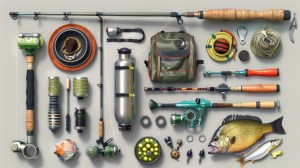Understanding Fishing Rod Types: What You Need for Your Favorite Techniques
Choosing the right fishing rod is crucial for enhancing your angling experience. With various types of fishing techniques, it’s important to understand which rod best suits your specific needs. In this article, we’ll explore different types of fishing rods and how to select the right one for your favorite techniques.
Types of Fishing Rods
Fishing rods come in several varieties, each designed for specific techniques. The most common types include spinning rods, casting rods, fly rods, and ice fishing rods. Spinning rods are versatile and great for beginners; casting rods offer more control and are suited for baitcasting techniques; fly rods are specifically tailored for fly fishing; while ice fishing rods are designed to be used in cold conditions. Understanding these fundamental differences is key when picking a rod that matches your technique.

Length and Action Explained
The length of a fishing rod can significantly impact your performance on the water. Longer rods generally allow you to cast farther but may be less sensitive when it comes to feeling bites. Conversely, shorter rods provide better control and sensitivity but have limited casting distance. Additionally, the action of a rod—whether it’s fast, medium, or slow—affects how much the tip bends during use. Fast action rods bend near the tip and provide quick response times, while slower action ones bend further down towards the handle.
Power Ratings: Finding Your Match
Rod power ratings range from ultra-light to heavy and indicate how much weight a rod can handle effectively. For finesse techniques like panfish or trout fishing, an ultra-light or light power rod works best due to its sensitivity and ability to handle lighter lures. Medium power is versatile enough for general freshwater species like bass or walleye; heavy power is typically used in saltwater applications or when targeting larger species such as pike or tarpon.
Material Matters: Graphite vs Fiberglass
The material of a fishing rod impacts its weight, sensitivity, durability, and overall performance. Graphite rods are lightweight with great sensitivity making them ideal for feeling even the slightest bites; they’re commonly used in freshwater applications. On the other hand, fiberglass offers more durability which can withstand rough handling but at the cost of sensitivity—making them suitable for beginners who may not need extreme precision yet.
Personal Preference: The Final Touch
Ultimately, choosing a fishing rod also boils down to personal preference including grip type (cork vs foam), reel seat comfortability, and aesthetic appeal like color or design patterns that resonate with you personally. It’s recommended that you try out different models at local tackle shops if possible so you can gauge what feels comfortable in hand before making your final decision.
In conclusion, selecting the right fishing rod requires consideration of various factors including type based on technique preference, length & action suitability as well as material choice among others. By understanding these elements better you’re sure to enhance not just effectiveness while angling but also overall enjoyment out on those beautiful waters.
This text was generated using a large language model, and select text has been reviewed and moderated for purposes such as readability.











